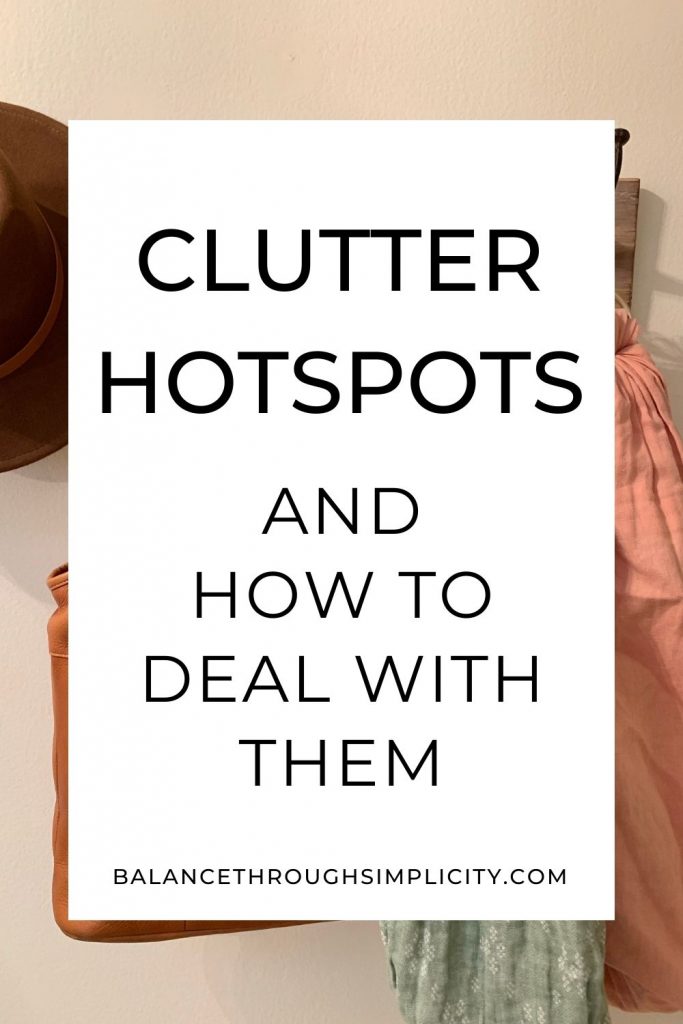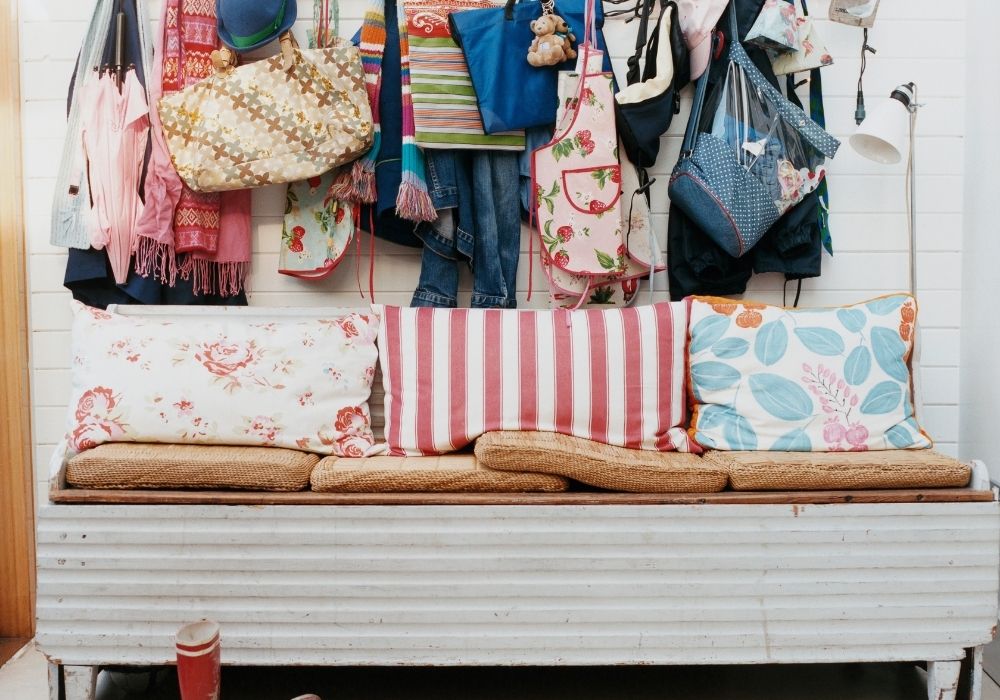CLUTTER HOTSPOTS AND HOW TO DEAL WITH THEM
Clutter hotspots are where clutter has a habit of building up regularly. In this article we’ll look at the main clutter hotspots in your home and I’ll share some tips on how to deal with them!
WHAT ARE CLUTTER HOTSPOTS?
If you take a look around your home, I bet there are some places that you notice clutter builds up (or tries to build up) more often than others? I can name a few in my own home for sure!
Even though you might be able to keep the rest of your home pretty clutter-free, it’s frustrating that some places always tend to attract clutter. And, as clutter attracts clutter, it becomes quite a job to keep these places clutter-free. These areas in your home where clutter has a tendency to build up are called clutter hotspots.
In this article I’d like to share some tips on how to deal with clutter hotspots. We’ll identify several common areas or types of item in your home which are notorious for attracting clutter, and some strategies to deal with it.
WHY ARE CLUTTER HOTSPOTS SO COMMON?
Even quite decluttered homes can have clutter hotspots. When I first began to declutter my own home several years ago, I was making good progress in some areas but found myself continually frustrated by some of the clutter that seemed resistant to my efforts!
Over the years, I’ve learnt to recognise these common clutter hotspots and have found some strategies that work to combat the clutter in them.
Clutter hotspots tend to build up in particular places for several reasons:
- In places of high use and traffic – often where several members of your household are coming and going and tend to dump things as they move through.
- On flat surfaces – such as counter-tops and tables where it’s a nice open space to empty out a bag, lay down a pile of paperwork or put something down whilst you get on with something else.
- In out of sight places – such as containers, bins or bags that are in regular use because it’s an easy way to put clutter out-of-sight and out-of-mind. Read more about this hidden clutter.
WHY DO CLUTTER HOTSPOTS MATTER?
If you’ve spent a while decluttering your home, you’ll know that it requires effort! How frustrating it is to feel that your decluttering efforts have been wasted when you look around your home and see piles of stuff on your kitchen counters or the hallway table? No matter how much you’ve decluttered the rest of these rooms, if you’ve got a pile of stuff on your counter or table, these rooms are going to still look cluttered and perhaps, ugly and unsightly.
Clutter lurking around is also difficult to clean and tidy. You’ll probably have to move that paperwork to clean your kitchen counter, or sort through the junk mail on your hall table to find the letter you were looking for.
Not only can clutter look unsightly but it makes it more difficult to clean and stay organised. Furthermore, clutter attracts clutter. If you’ve got that pile of papers on your kitchen counter, I bet you’ll find that by the end of the day or week, a little bit more stuff has joined that pile! It feels like just one more piece of clutter won’t matter so we add to the pile. Clutter hotspots are also known as clutter magnets for that very reason!
If you’re going to put in the effort to declutter your home and keep that clutter away, then you don’t want those unsightly clutter hotspots undoing your hard work!

CLUTTER HOTSPOTS AND HOW TO DEAL WITH THEM
I’d like to share some examples of common clutter hotspots and some tips and strategies on how to deal with them!
1. Kitchen counter
The kitchen is a busy place and many families tend to congregate in there, not just at mealtimes. As a result, those nice spacious kitchen counters seem like a perfect dumping ground for bags, paperwork and random clutter.
How to avoid this:
- Keep your kitchen counters clear by identifying the clutter that builds up there and creating alternative ‘homes’ and storage for that clutter to be put away in when not in use (or waiting to be used or dealt with).
- Clearing the counters regularly throughout the day.
- Don’t leave appliances out when not in use.
- Make sure all cupboards are easy to open and take things in and out of.
- Find a specific place for paper clutter waiting to be actioned, filed, shredded or recycled.
Further reading: How to declutter kitchen counters and keep them clutter-free
2. The entrance way and hall
The entrance way and hall are another busy area of your home with people, pets and stuff moving to and fro throughout the day. It’s easy for us all to just fling things down as we step in through the front door. Bags, coats, shoes, wellies, footballs, school bags, dog leads, umbrellas and even junk mail, all contribute to clutter in the entrance way and hall – and on a daily basis!
How to avoid this:
- Give everything a home for items to be stored in when not in use.
- Most importantly, it needs to be as easy for you and your family to put things away as it is to leave them out! For example, hooks are quick to hang things on.
- Make sure storage is easily accessible for everyone who needs it. It might need to be low down for your kids to reach it.
- Teach your family to put things away right after they’ve finished using them. So, for example, take your coat off as you come in and put it straight onto the hook or into the cupboard etc.
- Utilise organisers for smaller items such as keys, sunglasses.
- Choose a hall table with drawers to store smaller items.

3. Your bag
I have my bag with me everywhere I go. It’s a habit that’s stayed with me from when my kids were little and all the stuff that babies and small children need when they go out and about. As handy as it is to have a bag which fits a lot in it, the downside is that our bags can be little mobile clutter hotspots. Coins, hair clips, receipts, pens and sweets gather at the bottom and get forgotten about!
How to avoid this:
- Keep your bag neat and tidy. Tip everything out at the end of each day or once a week. Only put back what you absolutely need.
- Invest in a bag with compartments or buy some smaller individual bags to divide items out so it’s easy to find what you’re looking for without having to pull everything out!
- Choose a smaller bag so you can’t fit clutter into it.
4. Bedside table
As you empty out your pockets or bag in the evening, do you pop everything on your bedside table? What about that stack of books you’ve yet to read? Or the items you use for your bedtime routine such as creams, medicines, drinks, chargers etc?
How to avoid this:
- Keep the surface clutter-free as it’s easier to keep clean and tidy. Only have what you really need for the night.
- Put everything you need for the night into a drawer instead of visible on the top. Make sure you don’t clutter up that drawer though!

5. Table-tops and flat surfaces
Any flat surface is likely to be a clutter magnet, just like those kitchen counters we mentioned above, as they’re easily accessible.
How to avoid this:
- Reduce surface clutter by removing furniture that doesn’t serve a purpose or is something you really love to look at. Don’t add in a table just because you have a bit of blank space to fill. The chances are you’ll fill that space with clutter as well as the table.
- Do a regular sweep of your surfaces every day (or more) to check for surface clutter.
- Keep a mental note of what sort of clutter builds up on those flat surfaces and find an alternative home for it instead.
- Find a functional but nice looking storage solution to organise persistent clutter. For example, a pretty set of filing trays to contain paperwork that needs sorting.
6. Spare bedroom
Perhaps you’ve made great progress in decluttering other areas of your home but you don’t have time to get rid of your unwanted items? Whilst you find the time, maybe you put all this unwanted clutter in your spare room where it’s not going to be seen by many people other than you and it’s at least out of the way in a room you don’t use very often. Sound familiar?! The problem with this is that clutter here can be out-of-sight and out-of-mind so we’re not reminded of it often enough to make us deal with it. And, when there’s one bag of clutter in here, it’s easy to add another, and another…
How to avoid this:
- Don’t put your unwanted clutter out of the way. Keep it where you’re likely to see it and be reminded of it daily. This way you’ll be more likely to want to get it out of your home!
- Have a plan for what you’re going to do with your unwanted stuff and deal with it as part of any decluttering session.
Further reading: What to do with unwanted stuff you’ve decluttered
7. Fridge, freezer and pantry
If you rummage at the back of your fridge, freezer or food cupboards can you find food that’s stale, out-of-date or that you don’t like to eat or cook? Your fridge, freezer and pantry can be clutter hotspots without us realising. How many of you just reach into the fridge, freezer or pantry for what you’re cooking and put off checking the full inventory until you’ve got more time, and then put it off some more…?
How to avoid this:
- Do a regular check of your fridge and freezer, stock-take once a week or month and put it in your diary.
- Plan your meals so you’re only buying food that you’re actually going to use.
- Avoid stock-piling if you don’t have the space or a plan to use the items any time soon.
Further reading: Meal-planning made simple
8. Stairs
Stairs are just like any other flat surface so clutter will build up here too. Perhaps you put stuff at the top of the stairs to bring down, or at the bottom of the stairs to take up? Either way, sometimes we forget or can’t carry the items, or put it off until tomorrow or the next day. Not only are they a trip hazard, but clutter on the stairs takes up space in what’s probably an already tight space and will instantly make the space look smaller and more cramped.
How to avoid this:
- Ask your family to help carry the items up or down whenever they’re passing.
- Don’t leave items on the stairs at all
- Get some extra exercise by making a special trip up or down (only if you’re physically able of course).
- Make a pact with yourself not to go to bed until you’ve cleared the stairs!
9. Drawers and cupboards
As Joshua Becker says “If you’re not using the stuff in your home, get rid of it. You’re not going to start using it more by shoving it in a closet somewhere.”
Just like the spare bedroom above, putting your clutter away so you can’t see it won’t help you have a clutter-free home and life. The clutter will still be there and you may well add to it from time to time.
How to avoid this:
- Treat your drawers and cupboards as though they were visible shelves or counters in your home, or pretend they had glass fronts so you can see what’s inside them! Just because you can close the drawer or shut the cupboard or closet door, doesn’t mean that these spaces don’t need to be tidy, organised and clutter-free. You’ll find things so much more easily and maximise the space in your home if you stop ‘shoving it in a closet somewhere’!

10. Wardrobe
I don’t buy new clothes very often but I still find that my wardrobe gets cluttered after a while. It could be with clothes that have worn out but I haven’t got rid of yet, or my style or size has changed. Maybe even the seasons have changed and my summer clothes have got pushed to the back whilst I’ve been wearing my winter clothes. It might even be that I’ve bought a new pair of jeans to replace an old pair, but then I keep the old pair as gardening or painting jeans!
Our wardrobes, like the cupboards we mentioned above, can become clutter hotspots. But, of course, this makes it difficult to get dressed quickly and easily in the busy mornings in clothes that we actually feel and look great in!
How to avoid this:
- Check through your wardrobe regularly, at least at the start of every season.
- Declutter clothes that don’t fit, you don’t like to wear, or are damaged.
- Clean the inside and hang as much up as possible so it’s clearly visible.
- Don’t store anything in your wardrobe that’s not clothing or clothing-related!
Further reading: How to declutter clothes
11. Garage and attic
The garage and attic are clutter hotspots for usually for two reasons. Firstly, they’re relatively big spaces and secondly, they’re out-of-sight and out-of-mind. Whilst they’re often legitimate storage places for DIY stuff, seasonal décor etc, and they can be great temporary holding places for unwanted clutter that you’re getting rid of, the garage and attic are not dumping grounds for random stuff you don’t know what to do with.
How to avoid this:
- Give everything in your home its own ‘home’ – a place to live and be stored when not in use.
- Use containers and other storage solutions to maximise space and keep everything separated by category and with clear labels to make it easy to find things. If something isn’t clearly identifiable with a home and/or label, do you really need to keep it?
- Declutter your garage and attic as regularly as you need and treat it a little like any other room in your home that you try to keep clutter-free and tidy.
- Limit the number of storage solutions and use this limit to define how much you’re keeping.
- If you don’t use something, know how to use it or want to use it, let it go.
Further reading: Decluttering questions to help you declutter more effectively
12. Your email inbox and phone
How many emails do you have in your inbox or photos on your phone? Although they won’t produce visible clutter in the same way as stuff in your home, too much digital clutter on your phone and devices can still be overwhelming. It’s much more difficult to find the email or photo you’re looking for if it’s buried in amongst thousands of other emails or photos.
How to avoid this:
- Check through your emails regularly.
- Create a system for organising emails into folders by topic.
- Unsubscribe or delete emails that you don’t find value in and action the ones that need you to do something.
- Delete photos on your phone that are fuzzy or duplicates.
- Save your others to a cloud-based system so they don’t take up space on your phone.
Further reading: How to declutter your digital clutter

SHARE YOUR THOUGHTS
Let me know in the comments below if you have any clutter hotspots in your home. Have you found ways to tackle them or do you ignore them?! Is it just you adding to that clutter or does your family dump stuff there too? What tips could you share to help others who also struggle with clutter hotspots? I’d love to hear from you so leave a comment below!
DECLUTTERING RESOURCES
Here are some other articles and resources with decluttering tips, advice and information. If you’re looking for ways to declutter your home with minimum effort and maximum impact, I hope you find these decluttering resources helpful:
- ‘Just In Case’ Clutter: what it is and how to deal with it
- Decluttering mistakes and how to overcome them
- How to declutter fast: tips on decluttering quickly
- How to find the motivation to declutter your home
- 20 habits for a clutter-free home
- Simplify Your Home: a guide, workbook and checklists to help you declutter your home, step-by-step.

